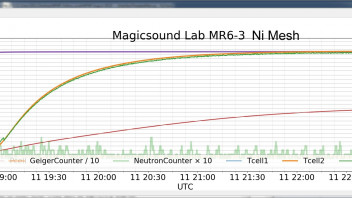A few weeks ago I posted experimental results showing samples of Pd coated Ni mesh were substantially loaded with H from environmental exposure at ambient temperature. If flux of H is a key parameter to activate LENR in this material, such uncontrolled pre-loading may be why replication is inconsistent.
As a first step in controlling the flux process, I did some further tests. In two successive runs I compared the out-gassing of an untreated Ni mesh and a Pd-coated mesh. In each case, the reactor was pumped out to 5E-4 Torr for about 10 minutes, but no heat was applied during this vacuum phase. With the vacuum system off, 47 watts heater power was applied for 4 hours, while the pressure was recorded.
About 750 Pa of out-gassing was seen from the untreated mesh, probably water vapor and atmospheric gases adhered to the Ni and the inner surface of the SS reactor shell. The Pd coated mesh produced 2100 Pa of out-gassing under identical conditions, of which about 1/3 would be the water vapor and atmospheric gases adhered to the surfaces, and the remainder H species unloaded from the Pd as the metal was heated. No excess heat or radiation was detected in either case.
My conclusion from this is that extended de-gassing at just over 100°C should be done at the start of a test, to remove water vapor and other atmospheric traces in the cell - unless the presence of water vapor is a necessary part of the LENR reaction. I haven't seen that proposed in discussion of this gas-phase LENR system, but it's certainly possible. For example, Bob Greenyer proposed that the small amount of D2O in the "LION" cell produced a plasma reaction with the diamond bits that were soaked in it. My attempt to replicate that experiment yielded nothing of interest. Bob later said that the 1000°C+ I ran wasn't hot enough...


